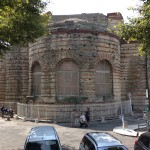
When you take a river cruise, or any cruise for that matter, each day you must choose from different excursions.
These excursions, as you might guess, are not created around the theme of the history of the expansion of the kingdom of God on earth. This requires one to improvise.
Today was no different. We traveled by bus from our port in Avignon to Arles, France, an ancient town to the south on the Rhone. Our excursion was billed a “Walking Tour of Arles.”
It should have been named, “Vincent Van Gogh: Man or Myth.” How something labeled as a generic walking tour through these ancient Roman ruins could become a panegyric for a troubled self-mutilating artist who only spent 18 months here is beyond me.
By the end of the tour our guide was referring to Van Gogh (pronounced “Van Gaw” if you didn’t know) as “Vincent.” I thought maybe she knew him, but that would make her like 120 years old. 120 may be the new 110, but it certainly isn’t the new 30.
Toward the end of the tour, our guide walked right by the baths of Constantine with barely a mention. At that point we decided to make our exit from the group and paid the tariff for entry into the ruins.
Constantine the Great was the first Christian emperor of the Roman Empire. His rule is a fascinating study in the exercise of the delegated authority of King Jesus on earth. As Jesus continues to transform lives, and the kingdom of God expands, more Christians will become leaders of their nations. They will begin to look to historical figures like Constantine to learn what to do and what not to do.
The baths of Constantine were built in the fourth century A.D. Constantine apparently visited Arles many times and apparently spent quite a bit of time here. His son, Constantine II, was born here. Constantine called the Council of Arles in 314 A.D. to address the Donatist controversy (a controversy that arose over how to treat those who had not remained faithful to Jesus during the persecution by Emperor Diocletian). In addition to the baths, Arles contains a Roman amphitheater, a theater and the remains of a forum. The Romans loved to bathe and they brought that luxury to the rest of the empire through the construction of public baths, which are roughly the modern of equivalent of spas, though they were more common and popular.
The Bible says cleanliness is next to godliness . . . . Okay maybe the Bible doesn’t say that, but if it did I would not question its inerrancy on that point. Some have referred to me as a germaphobe, but I don’t believe it’s true. To be a “phobe” means you have an unhealthy fear something. My fear of germs is not unhealthy but quite reasonable. I understand that germs are everywhere, and that as long as we engage in irresponsible practices like shaking hands, buffet lunches, and air travel, we will continue to get sick, all of which reminds me that I think I forgot to pack my Purell. GS

